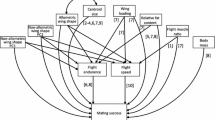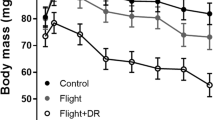Abstract
Flight performance is undoubtedly an important factor for behavioral success in flying insects. Though it is well-known that the flight performance is influenced by body temperature and body size, the relative importance of these factors is not well-understood. We performed laboratory experiments using the male-polymorphic damselfly Mnais costalis with larger territorial males and smaller non-territorial males in a population. We analyzed the effects of body temperature and body size, measured as the thoracic temperature and left hind-wing length, respectively, on two indices of flight performance: maximum lifting force and size-corrected lifting force. The latter is an index of acceleration that is related to aerial agility. The results showed that higher body temperature produced both larger maximum lifting force and larger size-corrected lifting force. In contrast, while larger size produced a larger maximum lifting force, it produced a lower size-corrected lifting force. The results of field measurements showed that territorial males had variable thoracic temperatures depending on the insolation in their territories. In contrast, non-territorial males had less variable and generally higher thoracic temperatures than territorial males as they are mostly found in sunny spots. Until now, the influence of body temperature on behavioral performance has remained unclear although considerable studies have suggested such influence. We showed, here, for the first time, combined effects of body size and body temperature on flight performance. We also showed that body temperature was influenced by the mating strategies of a damselfly. These findings provide new insights into the cost and benefits of territorial behavior in ectothermic animals.




Similar content being viewed by others
References
Alcock J, Kemp D (2006) The behavioral significance of male body size in the tarantula hawk wasp Hemipepsis ustulata (Hymenoptera: Pompilidae). Ethology 112:691–698
Almbro M, Kullberg C (2008) Impaired escape flight ability in butterflies due to low flight muscle ratio prior to hibernation. J Exp Biol 211:24–28
Almbro M, Kullberg C (2009) The downfall of mating: the effect of mate-carrying and flight muscle ratio on the escape ability of a pierid butterfly. Behav Ecol Sociobiol 63:413–420
Berwaerts K, Van Dyck H (2004) Take-off performance under optimal and suboptimal thermal conditions in the butterfly Pararge aegeria. Oecologia 141:536–545
Carchini G, Chiarotti F, Di Domenico M, Paganotti G (2000) Fluctuating asymmetry, size and mating success in males of Ischnura elegans (Vander Linden) (Odonata: Coenagrionidae). Anim Behav 59:177–182
Carchini G, Chiarotti F, Di Domenico M, Mattoccia M, Paganotti G (2001) Fluctuating asymmetry, mating success, body size and heterozygosity in Coenagrion scitulum (Rambur) (Odonata: Coenagrionidae). Anim Behav 61:661–669
Casey TM (1992) Biophysical ecology and heat-exchange in insects. Am Zool 32:225–237
Chai P, Srygley R (1990) Predation and the flight, morphology, and temperature of neotropical rain-forest butterflies. Am Nat 135:748–765
Coelho J, Holliday C (2001) Effects of size and flight performance on intermale mate competition in the cicada killer, Sphecius speciosus Drury (Hymenoptera: Sphecidae). J Insect Behav 14:345–351
Corbet PS (1999) Dragonflies: behavior and ecology of odonata. Comstock Pub Assoc, New York
De Block M, Stoks R (2007) Flight-related body morphology shapes mating success in a damselfly. Anim Behav 74:1093–1098
Dreisig H (1995) Thermoregulation and flight activity in territorial male graylings, Hipparchia semele (Satyridae), and large skippers, Ochlodes venata (Hesperiidae). Oecologia 101:169–176
Heinrich B (1993) The hot-blooded insects: strategies and mechanisms of thermoregulation. Harvard University Press, Cambridge
Kemp D (2000) Contest behavior in territorial male butterflies: does size matter? Behav Ecol 11:591–596
Larsson F, Kustvall V (1990) Temperature reverses size-dependent male mating success of a cerambycid beetle. Funct Ecol 4:85–90
Larsson FK, Tengo J (1989) The effects of temperature and body size on the mating pattern of a gregariously nesting bee, Colletes-Cunicularius (Hymenoptera, Colletidae). Ecol Entomol 14:279–286
Marden JH (1987) Maximum lift production during takeoff in flying animals. J Exp Biol 130:235–258
Marden JH (1989a) Bodybuilding dragonflies: costs and benefits of maximizing flight muscle. Physiol Zool 62:505–521
Marden JH (1989b) Effects of load-lifting constraints on the mating system of a dance fly. Ecology 70:496–502
Marden J, Cobb J (2004) Territorial and mating success of dragonflies that vary in muscle power output and presence of gregarine gut parasites. Anim Behav 68:857–865
May ML (1976) Thermoregulation and adaptaion to temperature in dragonflies (Odonata:Anisoptera). Ecol Monogr 46:1–32
May M (1981) Wingstroke frequency of dragonflies (Odonata: Anisoptera) in relation of temperature and body size. J Comp Physiol 144:229–240
May ML (1995) Dependence of flight behavior and heat production on air temperature in the green garner dragonfly Anax junius (Odonata: Aeshnidae). J Exp Biol 198:2385–2392
McLachlan AJ, Allen DF (1987) Male mating success in Diptera—advantages of small size. Oikos 48:11–14
Moya-Larano J, El-Sayyid MET, Fox CW (2007) Smaller beetles are better scramble competitors at cooler temperatures. Biol Let 3:475–478
Neems RM, Lazarus J, McLachlan AJ (1998) Lifetime reproductive success in a swarming midge: trade-offs and stabilizing selection for male body size. Behav Ecol 9:279–286
Plaistow S, Siva-Jothy M (1996) Energetic constraints and male mate-securing tactics in the damselfly Calopteryx splendens xanthostoma (Charpentier). Proc R Soc Lond B Biol Sci 263:1233–1239
Plaistow S, Tsubaki Y (2000) A selective trade-off for territoriality and non-territoriality in the polymorphic damselfly Mnais costalis. Proc R Soc Lond B Biol Sci 267:969–975
Serrano-Meneses MA, Cordoba-Aguilar A, Mendez V, Layen SJ, Szekely T (2007) Sexual size dimorphism in the American rubyspot: male body size predicts male competition and mating success. Anim Behav 73:987–997
Stevenson R (1985a) Body size and limits to the dairy range of body temperature in terrestrial ectotherms. Am Nat 125:102–117
Stevenson RD (1985b) The relative importance of behavioral and physiological adjustments controlling body temperature in terrestrial ectotherms. Am Nat 126:362–386
Stevenson R, Josephson R (1990) Efects of operating frequency and temperature on mechanical power output from moth flight muscle. J Exp Biol 149:61–78
Stoks R (2000) Components of lifetime mating success and body size in males of a scrambling damselfly. Anim Behav 59:339–348
Stutt A, Willmer P (1998) Territorial defence in speckled wood butterflies: do the hottest males always win? Anim Behav 55:1341–1347
Thompson DJ, Fincke OM (2002) Body size and fitness in Odonata, stabilising selection and a meta-analysis too far? Ecol Entomol 27:378–384
Tsubaki Y (2003) The genetic polymorphism linked to mate-securing strategies in the male damselfly Mnais costalis Selys (Odonata: Calopterygidae). Popul Ecol 45:263–266
Tsubaki Y, Hooper R, Siva-Jothy M (1997) Differences in adult and reproductive lifespan in the two male forms of Mnais pruinosa costalis Selys (Odonata: Calopterygidae). Res Popul Ecol 39:149–155
Van Dyck H, Matthysen E (1998) Thermoregulatory differences between phenotypes in the speckled wood butterfly: hot perchers and cold patrollers? Oecologia 114:326–334
Willmer P (1991) Thermal biology and mate acquisition in ectotherms. Trends Ecol Evol 6:396–399
Zamudio KRRBH, Crill WD (1995) Bigger isn’t always better: body size, developmental and parental temperature and male territorial success in Drosophila melanogaster. Anim Behav 49:671–677
Acknowledgments
We would like to thank Stewart Plaistow for reading and providing many valuable comments on an earlier version of this paper and Elizabeth Nakajima for critical reading of the manuscript. This research was financially supported in part by Global COE Program A06 to Kyoto University and Japan Ministry of Education, Science and Culture (No. 19201047 to YT).
Author information
Authors and Affiliations
Corresponding author
Additional information
Communicated by M. Siva-Jothy
Rights and permissions
About this article
Cite this article
Samejima, Y., Tsubaki, Y. Body temperature and body size affect flight performance in a damselfly. Behav Ecol Sociobiol 64, 685–692 (2010). https://doi.org/10.1007/s00265-009-0886-3
Received:
Revised:
Accepted:
Published:
Issue Date:
DOI: https://doi.org/10.1007/s00265-009-0886-3




